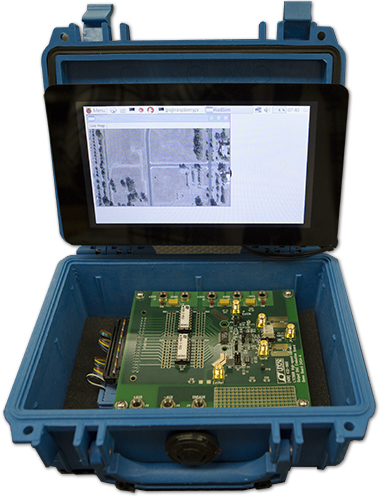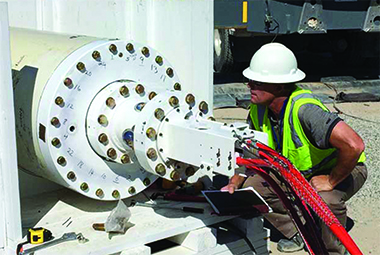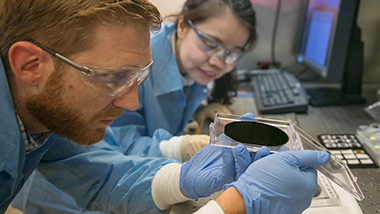Reducing the threat from terrorism and weapons of mass destruction and enhancing global stability
LLNL develops innovative advanced technologies to help the government anticipate, identify, and address global security threats. By applying scientific and engineering expertise in chemical, biological, radiological, nuclear, and explosive weapons, our experts support threat preparedness, prevention, protection, and response and recovery. Innovations in space situational awareness and cyber defense help strengthen national security in an interconnected world.
Tools to Search for Special Nuclear Materials
Law enforcement or homeland security agencies search for radiological or nuclear threats before many special events or when credible evidence exists that a device has been implanted. LLNL is leading a multilaboratory team that completed prototype development of the Optimization Planning Tool for Urban Search (OPTUS). The software program, which uses detailed physical descriptions of urban areas and sophisticated optimization algorithms, helps teams conduct more thorough searches in less time. Search teams and planners are now testing and refining OPTUS.
Livermore researchers also designed a device, called the Spectroscopic Injection Pulser (SIP), for training first responders to deal with the consequences of any nuclear incident. Training exercises on the use of radiation detectors typically employ relatively harmless, but less realistic, isotopes as surrogates for special nuclear materials. SIP adds realism by injecting into a radiation detector signals that would be detected if actual radioactive materials were present, taking into account the detector’s location relative to the supposed radiation sources. The technology, which was supported by Laboratory Directed Research and Development funding, has been demonstrated to representatives from U.S. federal agencies, the International Atomic Energy Agency (IAEA), and the Preparatory Commission for the Comprehensive Nuclear-Test-Ban Treaty Organization.
Tests to Better Detect Low-Yield Nuclear Explosions
LLNL researchers played a leading role in planning and conducting the final two Source Physics Experiments (SPEs) in the Phase I series. Phase I consisted of six underground high-explosive detonations in hard rock, designed to improve the United States’ ability to detect and identify low-yield nuclear explosions amid the clutter of conventional explosions and small earthquakes. SPE-5 was the highest yield test in the series, a 5-ton (TNT-equivalent yield) underground chemical explosion. Fired in April 2016, the test provided important information about how explosions generate shear waves, which are used to monitor nuclear tests. The jolt measured 2.0 on the Richter scale and was detected at several hundred seismic stations, including some at distances of more than 400 kilometers. SPE-6 was conducted in October 2016 and was the shallowest of the series. By comparing SPE-6 to the previous deeper high-explosives SPE tests and nearby historic underground nuclear tests, researchers are gaining a better understanding of the effects of depth and size on explosion-generated seismic signals.
Biosecurity Preparedness in the Subway
Researchers used DNATrax, developed at LLNL, to study how a biological agent, such as anthrax, released by accident or as a result of a terrorist attack might disperse throughout the nation’s largest rapid transit systems. An LLNL field team supervised the release of DNATrax, a harmless aerosol, at New York City’s Grand Central Terminal and two other major subway hubs. The team then helped collect environmental samples of the particles at more than 50 subway stations. The Department of Homeland Security sponsored the multiagency test, led by the MIT Lincoln Laboratory, to gather information to help local authorities and emergency management personnel in preparedness planning. This was the first comprehensive study of its kind performed on a major subway system during normal operating hours.
Human-on-a-Chip Monitors Live Neurons
Livermore researchers are working to predict the effects of potentially harmful chemicals, viruses, or drugs on humans without resorting to animal-based tests. They are testing an innovative “human-on-a-chip,” a miniature external replication of human-body organs that integrates biology and engineering with a combination of microfluidics and multielectrode arrays. Called the iCHIP (in-vitro Chip-based Human Investigational Platform), the device is the first platform to demonstrate that long-term culture and chemical interrogation of primary human brain neurons on microelectrode arrays is possible. Microelectrodes noninvasively monitor how live neurons seeded and grown on the chip interact and react to chemical stimuli ranging from caffeine to real chemical agents.
Apex Gold
Apex Gold was the first minister-level gathering to identify potential national and international actions in the event of a nuclear crisis. Held at LLNL, the two-day exercise in January 2016 was hosted by the U.S. Department of Energy and the Netherlands Ministry of Foreign Affairs. Ministers and other delegates from 37 nations attended as did representatives from the IAEA, INTERPOL, the European Union, and the United Nations. Presented with a hypothetical nuclear terrorism scenario, attendees worked together to determine response options. Livermore international security experts helped develop the scenario and hosted Laboratory tours and equipment demonstrations that provided context for the exercise. Apex Gold laid the groundwork for the Nuclear Security Summit, hosted by President Barack Obama, March 30–April 1, 2016. LLNL’s National Atmospheric Release and Advisory Center (NARAC) provided simulations to the Nuclear Security Summit. The White House recognized the valuable support that NARAC provided.
A “Smart Skin” to Protect Soldiers
Laboratory scientists are applying nanotechnology to create military-grade clothing for protecting U.S. soldiers from chemical and biological attacks. The research, conducted for the Defense Threat Reduction Agency, aims to provide soldiers with breathable and lightweight protective suits within 10 years. The “smart skin” features flexible polymeric membranes with aligned carbon nanotube channels that are 5,000 times smaller than the width of a human hair. Sweat and air move easily through the nanotubes, and tests have shown that bacteria and viruses are too large to pass. LLNL scientists and collaborators are now examining two options to sense, react, and block smaller-diameter chemical agents from entering the nanotubes.









